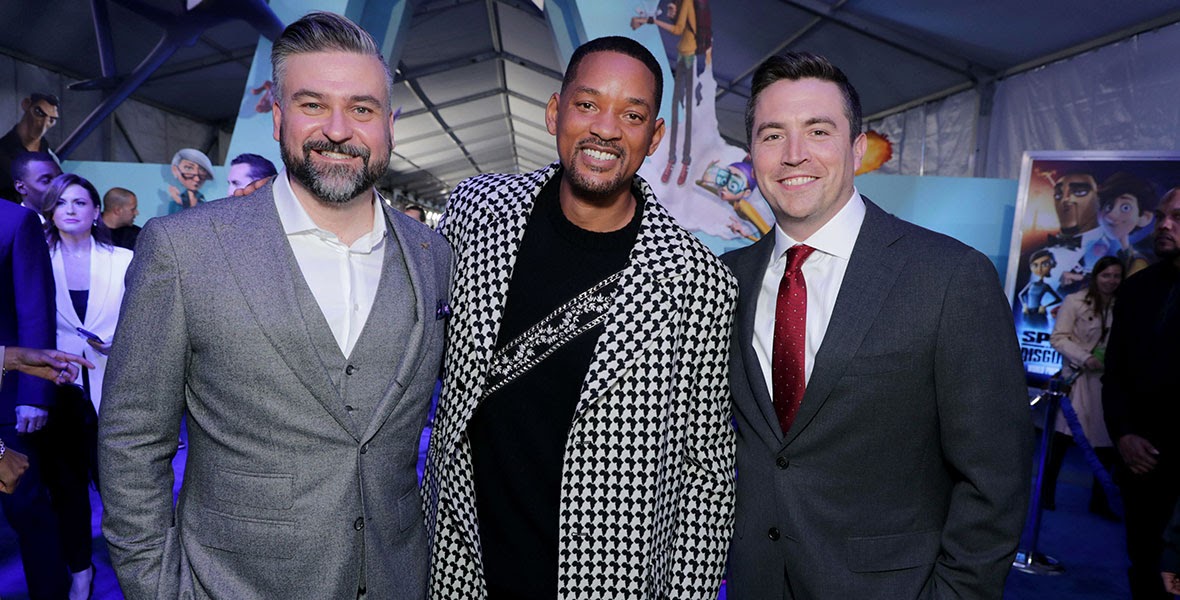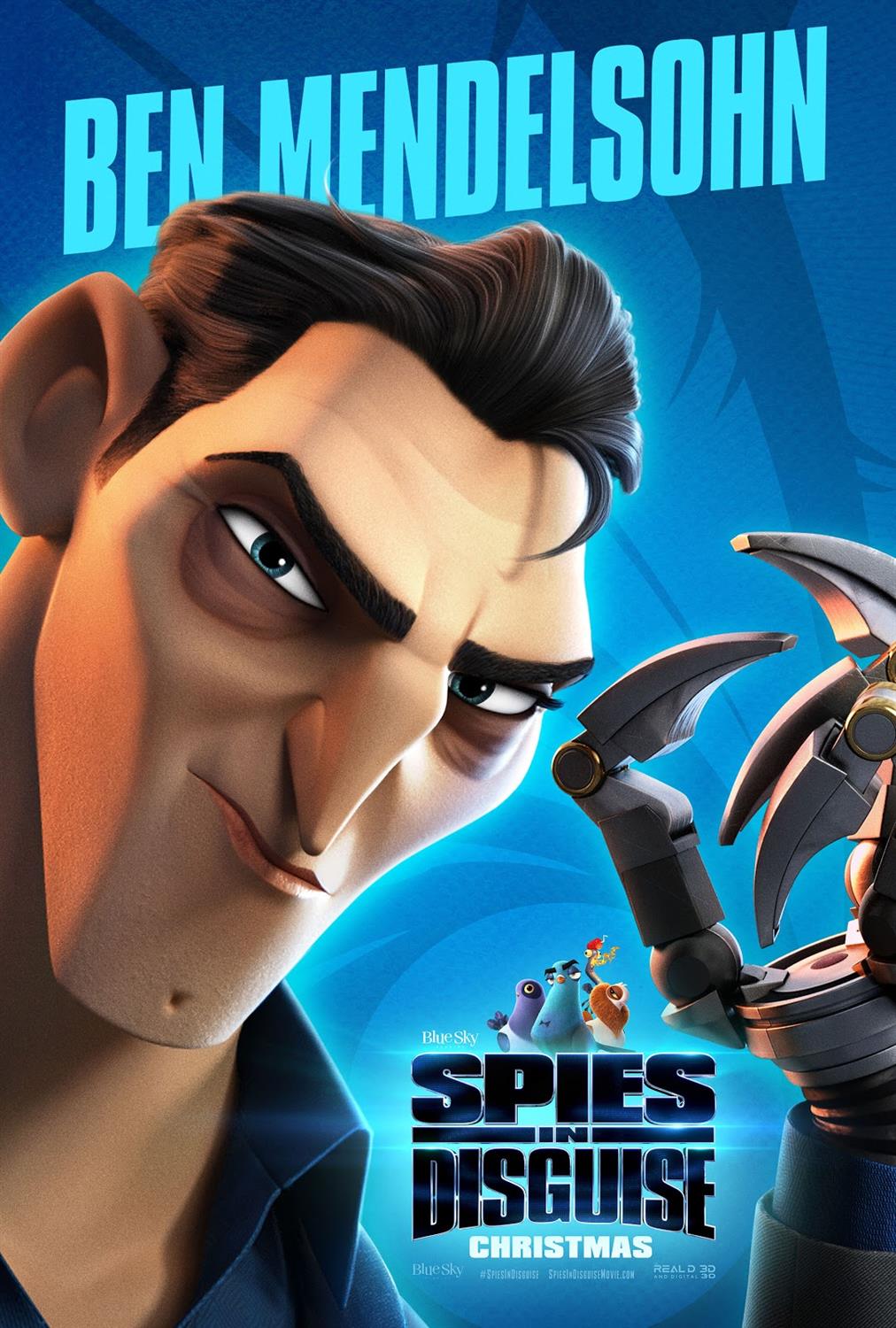Interview: “Spies in Disguise” Directors Nick Bruno and Troy Quane
Animator Nick Bruno got his start working on the Ice Age franchise for Blue Sky Studios, going on to contribute to Horton Hears a Who!, Rio, Epic, and The Peanuts Movie for the company. Similarly, Troy Quane began his career as a design supervisor, animator, and storyboard artist on movies like 9, Osmosis Jones, Ice Age: Collision Course, and Disney’s Enchanted. Now they have united their talents to act as directors of the new Will Smith / Tom Holland animated action-comedy Spies in Disguise for Blue Sky, being released under the now-Disney-owned 20th Century Fox Animation.
I recently had the terrific opportunity to sit down for a roundtable interview with Nick Bruno, Troy Quane, and a number of other reporters to discuss the duo’s collaboration on Spies in Disguise, what it’s like working with Will Smith and Tom Holland, and why they’re appreciative of their movie’s December release.
Q: How did you guys both come aboard Spies in Disguise?
Nick Bruno: I read the first draft of the script and I fell in love with [it]. It had the promise of all the big action spy movies, had all the fun tropes, but at its core it's really about working together. And I loved having that story in a spy world where nobody trusts each other, nobody works together. So I really fell in love with the project and I thought it could be a lot of fun [and] have a really good message.
Troy Quane: I think I read the script [in] October, 2013. And it was about a spy turning into a pigeon, which was crazy, but it was a spy movie, which is my favorite genre and it's just this opportunity to make a really big, bold, comedy [with] travel-the-world action set pieces. But like Nick said, it had really great characters at its heart. The characters of Lance and Walter were really defined and felt like there's something really interesting to explore there in this relationship. So we packed up the carriages and rolled East to Connecticut and moved up to Blue Sky and that's actually where I met Nick, when we came together on this film. It was like Lance and Walter, a match made in heaven. We fell in love. [laughs]
Bruno: We did, yeah. [laughs]
Q: How did you approach the concept of Will Smith’s spy character Lance Sterling turning into a pigeon?
Quane: That was one of the really fun aspects, being able to get into the movie from a completely different point of view, which is the pigeon antics. Pigeons are these things that most people ignore or think are gross or but they're really phenomenal. That's kind of where Walter's genius comes into play. As a spy, there's no better thing to be than a pigeon. I mean, they're in every major city around the world. People ignore them for the most part, but they've got all kinds of really cool sort of special abilities. Pigeons can fly really fast, up to 92.7 miles an hour. The only natural predator they have is the peregrine falcon.
Pigeons can bank at almost 90 degrees, which is unbelievable. We've watched YouTube videos with them drafting behind cars and traffic. They've got eyes on the side of their head so they can see an almost 360 degrees, so nobody could sneak up behind you, which is a pretty cool thing if you're a spy. They can see UV light, so the idea [is] that they can possibly see infrared sensors and lasers. There [are] all these really cool fun things that are like these built in gadgets and we had a lot of fun with that. The idea of being able to see someone's face and your butt at the same time becomes a really big joke in the movie. And it was really important that we took Lance Sterling, who's this amazing human physical specimen [with] broad shoulders and [a] strong chest-- he’s sexy-- and [turned] him into this really funny little dumpy bird shape.
But in order to do that, it was really important that as part of the fun of the pigeons, all the other animals in this world are just that: they're animals. We really needed that grounding reality, so you felt the difference of this human trapped in a pigeon body versus other real-world pigeons. So Lance is the only one who could talk, he's got little eyebrows so you can sort of read his expressions. It is the idea of this agent that flies solo becoming a flock animal and having to learn to deal with all these other quirky, crazy birds.
Q: With Tom Holland’s gadget inventor character Walter Beckett, was there ever a possibility of letting the actor use his own British accent?
Bruno: Yes, there was. But ultimately for the character of Walter, [he] is somebody who hasn't really gone out and seen the world. [Per] our earlier conversations with Tom, we all felt as a group it was better to keep him just as a kid who grew up in [Washington] D.C. who experienced a tragic past. So he's still worldly in that sort of experience, but you really want to feel like when he's out in the world, this is the first time he's experiencing all this new adventure, unlike Lance Sterling.
Quane: But, to the question of accents, the fun of these spy movies are [that] they're global. We really wanted to make sure that there was a texture for that. That pallet of sounds was important. While Tom uses his American accent, we've got Karen Gillan who uses her Scottish accent and Ben Mendelsohn uses his Australian accent. We made sure we cast Masi [Oka] so when we have the Japanese characters [they] are speaking true to their dialect, because we didn't want it to be someone just doing a funny accent. We really wanted it to be authentic. And then even within the American dialect, we have Reba McEntire who comes in with this wonderful southern twang. Again, it was about texture and making it feel big and broad in its scope.
Bruno: It represents the world that we see.
Q: Can you talk a little bit about developing the 1960s spy-movie aesthetics of this film?
Bruno: When we first started, we did our research and really enjoyed going back and watching all the spy films. And one of the things that we really loved was all those title sequences. But because this movie is fully animated, we can do more of that, so we looked at some of their angularity and their shape and their color language and we'd just try to find ways to get that DNA into every frame of the film.
Quane: But not necessarily make it feel like a vintage throwback. We really wanted it to feel contemporary and current. So it was finding what were the aesthetic design principles that we appreciated there, but making it feel very current so it didn't even feel like it was a throwback.
Bruno: And we did this same thing with the music and that's why we chose [composer] Mark Ronson. Mark does a great job of taking some throwback vibes, but giving it a contemporary spin so that it sounds full and contemporary.
Quane: Yeah, that big brass sound. It's so cool.
Bruno: We'd like to think of this movie as a love letter to all spy movies. We know that for kids this might be their first real spy movie so we wanted to do it justice. So again, we did our research, we went back, we watched all the Bonds, the Bournes, the Hunts. Watch all those guys. And there's definitely some homages in there to some other movies. But at the same time, like Troy was saying, we want to do something different and because it's a movie for kids we felt there was a responsibility to say something about teamwork. So it's not just about violence and explosions, it's really about coming together can save the world.
Q: Do you feel that there is also a lesson about gender politics and the toxic masculinity inherent in the spy genre?
Bruno: Yeah, absolutely. That came down to some of the tricky casting, which is how we ended up with Will Smith. I mean [for] the idea of Lance Sterling, we wanted to create a spy that stood alongside all those other great movies spies. But to that point, he's a character who doesn't work well with others, who's very confident but is still very charismatic. There's a lot of balancing to having that happen, and you needed someone like Will who could come in and really walk that line delicately. We love to cheer for those characters, but at the same time acknowledge that sometimes they have the wrong end of the stick on how they see the world.
And that's where bringing in someone like Walter and having Tom Holland, who could play [him] with such sincerity to… not show Lance that he's wrong, but show Lance there's another way. There's maybe a broader way of looking at the world and a broader way of interacting with the world. It felt like [that] was a very poignant part of the message, especially in today's day and age.
Q: Was there any difficulty with the ratings board over how much action and gunplay there could be in a kids movie?
Quane: No, actually not at all. But we were very specific with how we approached violence in the movie. It felt false to pretend that there wasn't violence in the world. I mean, you turn on the news and you know that that's not the case, but we were really specific in how we were using it-- that we weren't glorifying it. It was mainly at the hands of the bad guys. You needed that to counterpoint Walter's message of saying there's a better way. When we use violence to solve our issues, all we do is create more enemies.
We draw a line that puts people on the other side of that. We have to reach across that line and bring people together. So I think because the messaging was on point that we were really trying to say something in the movie, the action fits into that. It doesn't feel arbitrary or gratuitous. I mean, it's a lot of fun. It's a bunch of pigeons and a clumsy kid and goofy stuff happening. We wanted to make it fun and not too intense.
Bruno: Yeah, in no way did we glorify violence, because our message is against violence.
Spies in Disguise will be released into theaters on Christmas Day-- Wednesday, December 25.







